2.6.2 - Antithetical situations, same effects.
In the preceding page, I considered a balanced situation, where the intervals between successive tidal waves, keep almost equal for several days. That's possible only near the equinoxes.
Here, by contrast, I consider a condition possible only close to a solstice day, when the declination of the Sun, relative to the Earth equatorial plane, is at one of its highest values. Then, the intervals, between two successive waves, may be hugely unbalanced.
==================================================================
© copyright notice ||| français ||| italiano
prologue > index tides > 2.6 - examples of tide waves.
2010-06 2.6.1 Almost equal intervals in a series of tidal waves.
> 2010-06 2.6.2 Antithetical situations, same effects.
2010-06 2.6.3 In a neap tide.
2010-06 2.6.4 The role of the Sun in the tides.
==================================================================
When the Moon and Sun work together.
Among the possible series of wave profiles, I here consider those where the moon and sun spatioles, in a semi-diurnal tidal basin, act either both in advance, or late.
Then, the larger intervals between successive tidal waves are recorded.
Apparently antithetical situations, same effects.
In the four combinations of the series here presented, even if the situations, during the generating phases, are antithetical, the ensuing wave profiles are almost identical, thanks to the lead and lag effects of the two spatioles, which reinforce each other in the same sense, as shown in the next graphs.
Recall: “spatioles”
In advance or late because of the declination.
Below, I present the provisional graph (updated on March 2012), valid for the lagoon of Venice, of the advance and delay (in minutes), due to the declination of the respective generating mass (either Moon, or Sun), of the centres of the times of the spatioles.
The bar line on the graph represents the passage of one of the two celestial bodies, either above the local meridian, or above the opposite one. The curve A (squares) represents the effect on the times during the passages above the local meridian; the curve B (lozenges), during the passages above the opposite meridian.
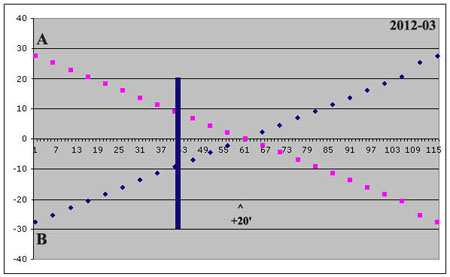
>> time >>
In advance or late because of the position.
Moreover, in the lagoon of Venice the spatioles show a delay of around 20 mns, because of its position relative to the base line of the tidal basin.
Legend of the tidal wave graphs.
On the numbers assigned to the tidal waves.
#1 - 2007 june 15, new moon.
The Sun presents the highest values of north declination, over 23°. The Moon too has very high north declination values (28°).
Since the Moon and the Sun are on the same side relative to the Earth (same position sign), and, on top of that, they have both the same sign of declination (north), the passages of the two spatioles are both either late, or early; it depends. Near noon they are both early; on the contrary, near midnight, they are both late. Around ten hours later, the tidal waves reach the lagoon.
Outcome.
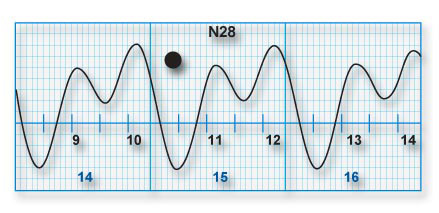
#2 - 2007 june 30, full moon.
Two weeks later, it is full Moon. Declinations: Sun 23° north; Moon 27° south.
Since the Moon and the Sun are now in opposition, with the Earth between them, but, at the same time, they also show opposite declination values, the passages of their spatioles are again both either late, or early; it depends. Near noon they are both early; on the contrary, near midnight, they are both late. Around ten hours later, the tidal waves reach the lagoon
Outcome.
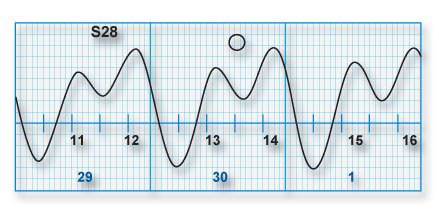
The two winter combinations.
Near the winter solstice, the two summer combinations of leads and lags are overturn; the tidal waves profiles keep the same shape, though everything on the graph is displaced by 12 hours.
#3 - 2008 december 12, full moon.
It's full moon. The Sun presents the highest values of south declination, over 23°. While the Moon has very high north declination values (27°).
Outcome.
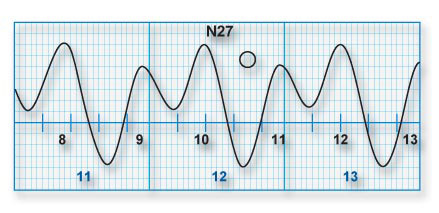
Two weeks later, it is new Moon. The Moon presents a south value declination (around 27° south).
Since the Moon and the Sun are on the same side relative to the Earth, and, at the same time, they have both the same sign of declination (south), the passages of the two spatioles are both either late, or early; it depends. Near noon they are both late; on the contrary, near midnight, they are both early. Around ten hours later, the tidal waves reach the lagoon
Outcome.
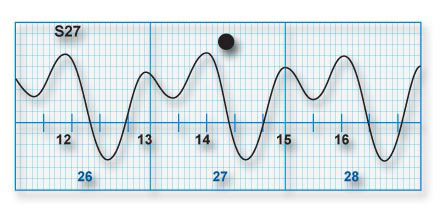
The longer intervals in summer.
In the two aforesaid summertime combinations, between the passages of the two spatioles near noon (early), and the passages of the two spatioles near midnight (late), there is the longer interval.Thus, as far as the interval between two tidal waves, in summertime, the longer one occurs during the first hours of the mornings.
In the two aforesaid winter combinations, between the passages of the two spatioles near midnight (early), and the passages of the two spatioles near noon (late), there is the longer interval.
As far as the interval between two tidal waves, in winter, the longer one occurs during the afternoon hours.